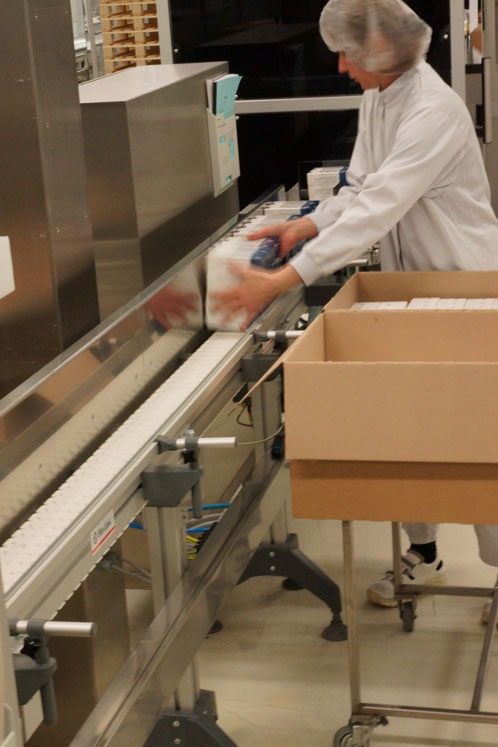Having introduced the concept of safety first, getting dosage sizes and pack completeness right, and serialisation in part I, the second half of this article expands on the key elements of the digital supply chain and shines a spotlight on the role of connectivity.
Previously alluding to the fact that producing a unique serial code is only part of the aggregation story, vision inspection systems are responsible for reading and quickly identifying packs with incorrect or poor-quality codes. This can save a great deal of time, money and resources by allowing line stops so that any faults can be quickly rectified and good quality coding can begin again.
In liquid pharma, the shapes and sizes of the primary packaging — bottles, vials, ampoules, etc. — present their own problems for serialisation and aggregation. For a start, as these kinds of vessels are typically round, they will rotate on the conveyer and periodically obscure the package label.
Good product handling is required when printing or applying serial codes directly onto pharmaceutical bottles, if that is the application. In vision inspection, it may be necessary to have technology that provides a full 360-degree view of the product surface, so that serialisation codes can be verified. Such a system would be able to view the product from all sides, regardless of orientation, and thus verify the serialised codes on the package.
A common practice with aggregated products is to use “helper codes” that are printed on top of the products, so that the data can be read even when the product is packed in a container with other items. This still requires some forethought and co-ordination, as not every vision inspection system is able to read codes on the tops of products.

It’s important for liquid pharma manufacturers to make an analysis of their applications, bearing in mind the type of packaging they want to use at the final point of sale. Understanding this will facilitate the implementation of serialisation and aggregation processes so they can assess what their vision inspection requirements will be.
For instance, in liquid pharma, equipment should be able to handle different types of round containers, read top or helper codes and verify datamatrix codes of various sizes.
Sharing data: The analysis must stretch beyond the factory walls too. Serial and aggregation data need to be shared with the supply chain, so it’s also critical that the technology deployed to read and verify codes can also communicate this information to the next links in the chain. That communication comes about through digital connectivity, requiring software systems that can talk to each other.
Step 3: Connectivity gives product data its true digital meaning
In the previous two steps, we’ve looked at ways in which product inspection equipment such as checkweighers and vision inspection systems can help liquid pharmaceutical manufacturers to manage the quality of their products. In this third step, we move onto the importance of software connectivity to bring this all together.
It’s a technical challenge to integrate software, but one in which pharma manufacturers and their technology suppliers must not cut corners; the benefits of getting this right can reach into every aspect of a manufacturer’s operation.
Connectivity: Equipping product inspection systems with the right software connectivity gives manufacturers a chance to gain a real-time picture of production, processing and packaging lines, allowing them to spot potential problems in advance.
It might help them to avoid issues arising in the first place; at the very least, they will be able to mitigate the damage and costs that they might incur. Being able to quickly pinpoint where something went wrong, and then quickly taking the action required to put it right, will also be appreciated by supply chain partners.
If we consider the word “connectivity” itself, we gain a greater appreciation of why software connectivity is so important. We exist in a marketplace that is increasingly interconnected, in which the supply chain is transforming towards a fully digital utility that every partner both feeds and taps into.
To achieve true transparency, such a supply chain requires data to be automatically gathered and shared by each partner and passed on via an efficient digital handshake from machine to machine, partner to partner.
Neither the handshake, nor the exchange of data can happen efficiently without software connectivity. In the areas of serialisation and aggregation, in particular, it’s crucial. The point of these activities, after all, is to enable the easy tracking of products, whether individually or as batches, through the supply chain. The data and the codes are pointless if they go nowhere. Building and sharing an audit trail of actions linked to serial codes serves multiple purposes.
Importance of data: First, data is a record of actions taken during manufacture and the onward processing of a product — information that might need to be referred back to in the event of a problem with the product (and as reference against attempts by counterfeit operations).

Secondly, the data gained is useful to prove that good manufacturing practices are being followed and meet the compliance requirements of different levels of regulation. Thirdly, without this access to digital data, real-time process monitoring and inventory management cannot meaningfully happen.
Role of product inspection: Pharma manufacturers will typically deploy checkweighing and vision inspection to make additional quality checks as needed. Track-and-trace is a requirement for serialisation and may be optional for aggregation (depending upon the region). Utilising all three of these technologies will help to support top-quality production methods and compliance.
Modern checkweighers and vision inspection systems should feature advanced software with robust security levels and in-built process monitoring capabilities. This should be aligned with global and local regulations that follow Good Automated Manufacturing Practice (GAMP 5) guidelines.
For track-and-trace systems, integration into MES- or ERP-systems (Level 5 software) ensures connectivity across single or multiple production sites and provides transparency into the production line data. The exchange of data should be managed through industry standard protocols and software architecture such as OPC UA, PackML and Fieldbus, which supports developments around the Internet of Things and Industry 4.0 initiatives.
Compliance: For European manufacturers, compliance with the EU Falsified Medicines Directive (FMD) requires reporting serialisation data to the European Medicines Verification Organisation (EMVO). Solutions for tracking and tracing the data must also include connectivity to Level 5 software, which in turn reports the data to the EMVO. Partner organisations must be technically certified to do the reporting and demonstrate that they have the technical feasibility to do so.
Additionally, the need to comply with requirements such as those set out by the US FDA CFR 21 Part 11 regulations must also be supported. This FDA clause specifically calls for machinery to create a local electronic audit trail, recording activity such as user logins and machine set-up adjustments.
Compliance, digital supply chain transparency, managing production issues and operating more efficiently and cost-effectively are some of the benefits that liquid pharma manufacturers stand to gain by taking a proactive view of software connectivity.
All of these have a bearing on overall product quality, a multifaceted aspiration for manufacturers in liquid pharma that incorporates the medication and the many processes by which that medication comes through the supply chain to market.
Conclusion
The key point to understand regarding quality assurance for liquid pharma packs is that strong product inspection capabilities are at the centre of any effective quality assurance programme. They help to make the production of liquid pharma products safe, complete, trackable and compliant with all levels of regulations. They play a critical function in creating and maintaining a transparent and connected digital supply chain.
Crucially, product inspection systems do this while helping manufacturers to meet output and profitability objectives by keeping production lines running with minimal downtime. Robust and thorough product inspection solutions ensure that liquid pharma manufacturers are able to overcome some of the many challenges they face today.




